Gustavo Hernandez Abrego
ATEB: Evaluating and Improving Advanced NLP Tasks for Text Embedding Models
Feb 24, 2025Abstract:Traditional text embedding benchmarks primarily evaluate embedding models' capabilities to capture semantic similarity. However, more advanced NLP tasks require a deeper understanding of text, such as safety and factuality. These tasks demand an ability to comprehend and process complex information, often involving the handling of sensitive content, or the verification of factual statements against reliable sources. We introduce a new benchmark designed to assess and highlight the limitations of embedding models trained on existing information retrieval data mixtures on advanced capabilities, which include factuality, safety, instruction following, reasoning and document-level understanding. This benchmark includes a diverse set of tasks that simulate real-world scenarios where these capabilities are critical and leads to identification of the gaps of the currently advanced embedding models. Furthermore, we propose a novel method that reformulates these various tasks as retrieval tasks. By framing tasks like safety or factuality classification as retrieval problems, we leverage the strengths of retrieval models in capturing semantic relationships while also pushing them to develop a deeper understanding of context and content. Using this approach with single-task fine-tuning, we achieved performance gains of 8\% on factuality classification and 13\% on safety classification. Our code and data will be publicly available.
Transforming LLMs into Cross-modal and Cross-lingual Retrieval Systems
Apr 04, 2024Abstract:Large language models (LLMs) are trained on text-only data that go far beyond the languages with paired speech and text data. At the same time, Dual Encoder (DE) based retrieval systems project queries and documents into the same embedding space and have demonstrated their success in retrieval and bi-text mining. To match speech and text in many languages, we propose using LLMs to initialize multi-modal DE retrieval systems. Unlike traditional methods, our system doesn't require speech data during LLM pre-training and can exploit LLM's multilingual text understanding capabilities to match speech and text in languages unseen during retrieval training. Our multi-modal LLM-based retrieval system is capable of matching speech and text in 102 languages despite only training on 21 languages. Our system outperforms previous systems trained explicitly on all 102 languages. We achieve a 10% absolute improvement in Recall@1 averaged across these languages. Additionally, our model demonstrates cross-lingual speech and text matching, which is further enhanced by readily available machine translation data.
Gecko: Versatile Text Embeddings Distilled from Large Language Models
Mar 29, 2024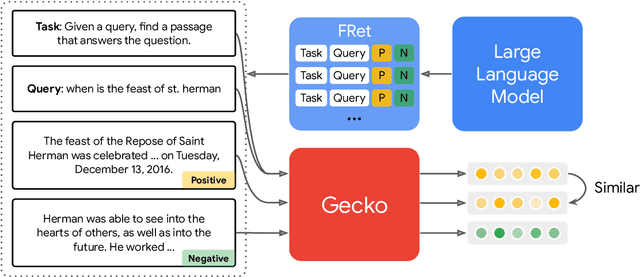


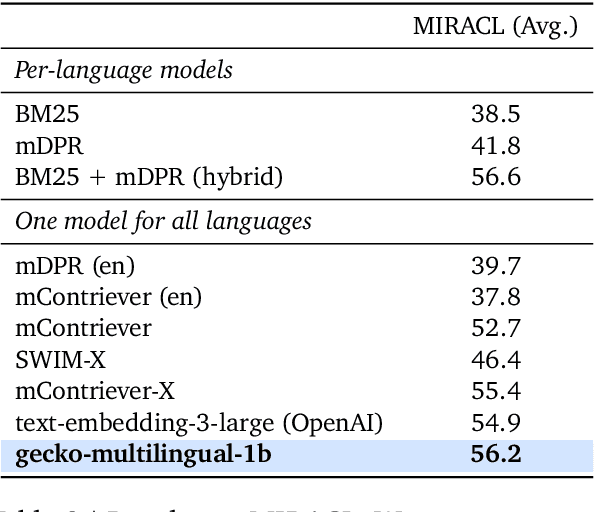
Abstract:We present Gecko, a compact and versatile text embedding model. Gecko achieves strong retrieval performance by leveraging a key idea: distilling knowledge from large language models (LLMs) into a retriever. Our two-step distillation process begins with generating diverse, synthetic paired data using an LLM. Next, we further refine the data quality by retrieving a set of candidate passages for each query, and relabeling the positive and hard negative passages using the same LLM. The effectiveness of our approach is demonstrated by the compactness of the Gecko. On the Massive Text Embedding Benchmark (MTEB), Gecko with 256 embedding dimensions outperforms all existing entries with 768 embedding size. Gecko with 768 embedding dimensions achieves an average score of 66.31, competing with 7x larger models and 5x higher dimensional embeddings.
SamToNe: Improving Contrastive Loss for Dual Encoder Retrieval Models with Same Tower Negatives
Jun 05, 2023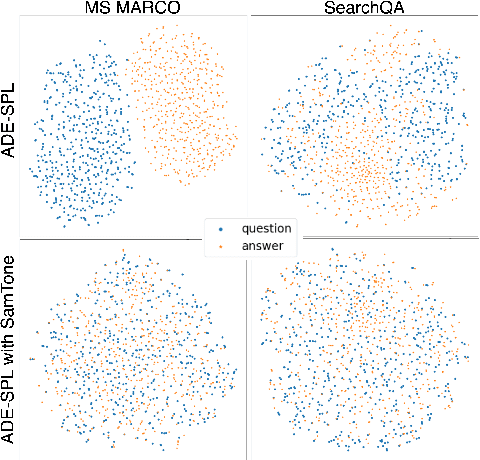
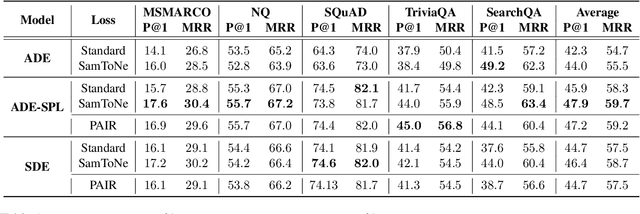
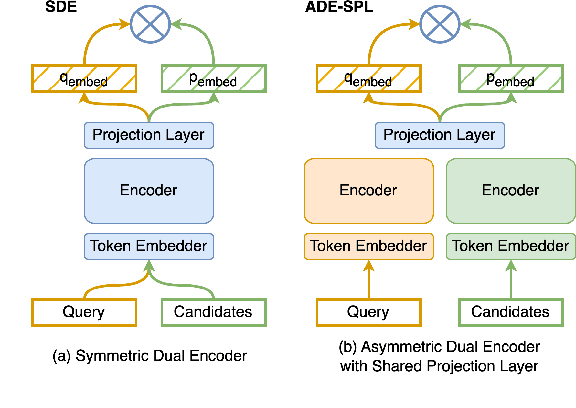

Abstract:Dual encoders have been used for retrieval tasks and representation learning with good results. A standard way to train dual encoders is using a contrastive loss with in-batch negatives. In this work, we propose an improved contrastive learning objective by adding queries or documents from the same encoder towers to the negatives, for which we name it as "contrastive loss with SAMe TOwer NEgatives" (SamToNe). By evaluating on question answering retrieval benchmarks from MS MARCO and MultiReQA, and heterogenous zero-shot information retrieval benchmarks (BEIR), we demonstrate that SamToNe can effectively improve the retrieval quality for both symmetric and asymmetric dual encoders. By directly probing the embedding spaces of the two encoding towers via the t-SNE algorithm (van der Maaten and Hinton, 2008), we observe that SamToNe ensures the alignment between the embedding spaces from the two encoder towers. Based on the analysis of the embedding distance distributions of the top-$1$ retrieved results, we further explain the efficacy of the method from the perspective of regularisation.
PaLM 2 Technical Report
May 17, 2023



Abstract:We introduce PaLM 2, a new state-of-the-art language model that has better multilingual and reasoning capabilities and is more compute-efficient than its predecessor PaLM. PaLM 2 is a Transformer-based model trained using a mixture of objectives. Through extensive evaluations on English and multilingual language, and reasoning tasks, we demonstrate that PaLM 2 has significantly improved quality on downstream tasks across different model sizes, while simultaneously exhibiting faster and more efficient inference compared to PaLM. This improved efficiency enables broader deployment while also allowing the model to respond faster, for a more natural pace of interaction. PaLM 2 demonstrates robust reasoning capabilities exemplified by large improvements over PaLM on BIG-Bench and other reasoning tasks. PaLM 2 exhibits stable performance on a suite of responsible AI evaluations, and enables inference-time control over toxicity without additional overhead or impact on other capabilities. Overall, PaLM 2 achieves state-of-the-art performance across a diverse set of tasks and capabilities. When discussing the PaLM 2 family, it is important to distinguish between pre-trained models (of various sizes), fine-tuned variants of these models, and the user-facing products that use these models. In particular, user-facing products typically include additional pre- and post-processing steps. Additionally, the underlying models may evolve over time. Therefore, one should not expect the performance of user-facing products to exactly match the results reported in this report.
Neural Passage Retrieval with Improved Negative Contrast
Oct 23, 2020



Abstract:In this paper we explore the effects of negative sampling in dual encoder models used to retrieve passages for automatic question answering. We explore four negative sampling strategies that complement the straightforward random sampling of negatives, typically used to train dual encoder models. Out of the four strategies, three are based on retrieval and one on heuristics. Our retrieval-based strategies are based on the semantic similarity and the lexical overlap between questions and passages. We train the dual encoder models in two stages: pre-training with synthetic data and fine tuning with domain-specific data. We apply negative sampling to both stages. The approach is evaluated in two passage retrieval tasks. Even though it is not evident that there is one single sampling strategy that works best in all the tasks, it is clear that our strategies contribute to improving the contrast between the response and all the other passages. Furthermore, mixing the negatives from different strategies achieve performance on par with the best performing strategy in all tasks. Our results establish a new state-of-the-art level of performance on two of the open-domain question answering datasets that we evaluated.
Multilingual Universal Sentence Encoder for Semantic Retrieval
Jul 09, 2019Abstract:We introduce two pre-trained retrieval focused multilingual sentence encoding models, respectively based on the Transformer and CNN model architectures. The models embed text from 16 languages into a single semantic space using a multi-task trained dual-encoder that learns tied representations using translation based bridge tasks (Chidambaram al., 2018). The models provide performance that is competitive with the state-of-the-art on: semantic retrieval (SR), translation pair bitext retrieval (BR) and retrieval question answering (ReQA). On English transfer learning tasks, our sentence-level embeddings approach, and in some cases exceed, the performance of monolingual, English only, sentence embedding models. Our models are made available for download on TensorFlow Hub.
Improving Multilingual Sentence Embedding using Bi-directional Dual Encoder with Additive Margin Softmax
Feb 22, 2019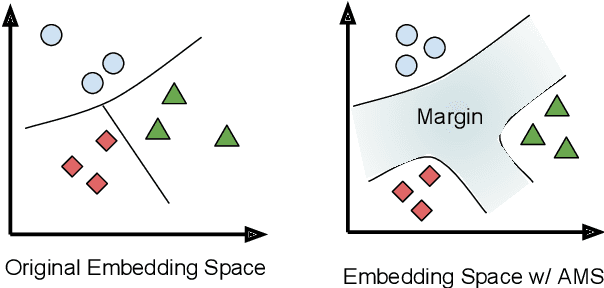

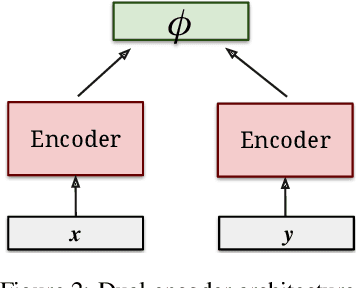

Abstract:In this paper, we present an approach to learn multilingual sentence embeddings using a bi-directional dual-encoder with additive margin softmax. The embeddings are able to achieve state-of-the-art results on the United Nations (UN) parallel corpus retrieval task. In all the languages tested, the system achieves P@1 of 86% or higher. We use pairs retrieved by our approach to train NMT models that achieve similar performance to models trained on gold pairs. We explore simple document-level embeddings constructed by averaging our sentence embeddings. On the UN document-level retrieval task, document embeddings achieve around 97% on P@1 for all experimented language pairs. Lastly, we evaluate the proposed model on the BUCC mining task. The learned embeddings with raw cosine similarity scores achieve competitive results compared to current state-of-the-art models, and with a second-stage scorer we achieve a new state-of-the-art level on this task.
Effective Parallel Corpus Mining using Bilingual Sentence Embeddings
Aug 02, 2018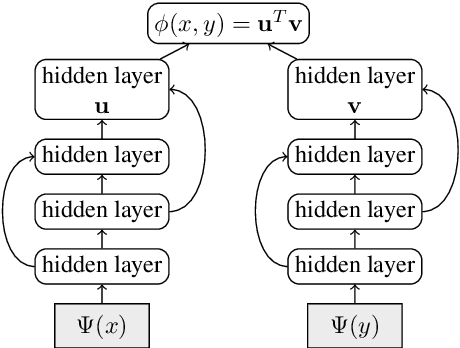
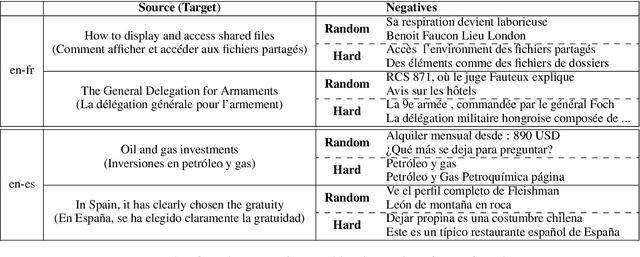
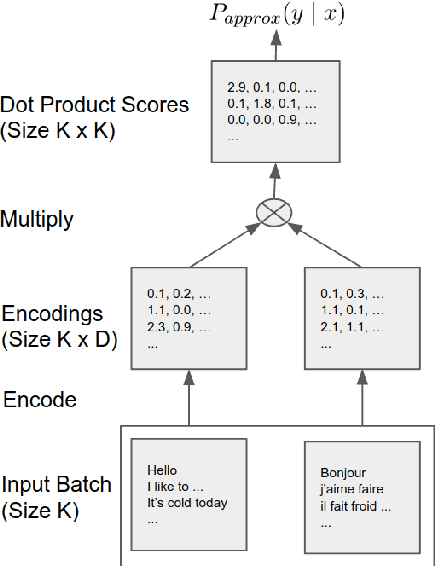

Abstract:This paper presents an effective approach for parallel corpus mining using bilingual sentence embeddings. Our embedding models are trained to produce similar representations exclusively for bilingual sentence pairs that are translations of each other. This is achieved using a novel training method that introduces hard negatives consisting of sentences that are not translations but that have some degree of semantic similarity. The quality of the resulting embeddings are evaluated on parallel corpus reconstruction and by assessing machine translation systems trained on gold vs. mined sentence pairs. We find that the sentence embeddings can be used to reconstruct the United Nations Parallel Corpus at the sentence level with a precision of 48.9% for en-fr and 54.9% for en-es. When adapted to document level matching, we achieve a parallel document matching accuracy that is comparable to the significantly more computationally intensive approach of [Jakob 2010]. Using reconstructed parallel data, we are able to train NMT models that perform nearly as well as models trained on the original data (within 1-2 BLEU).
 Add to Chrome
Add to Chrome Add to Firefox
Add to Firefox Add to Edge
Add to Edge